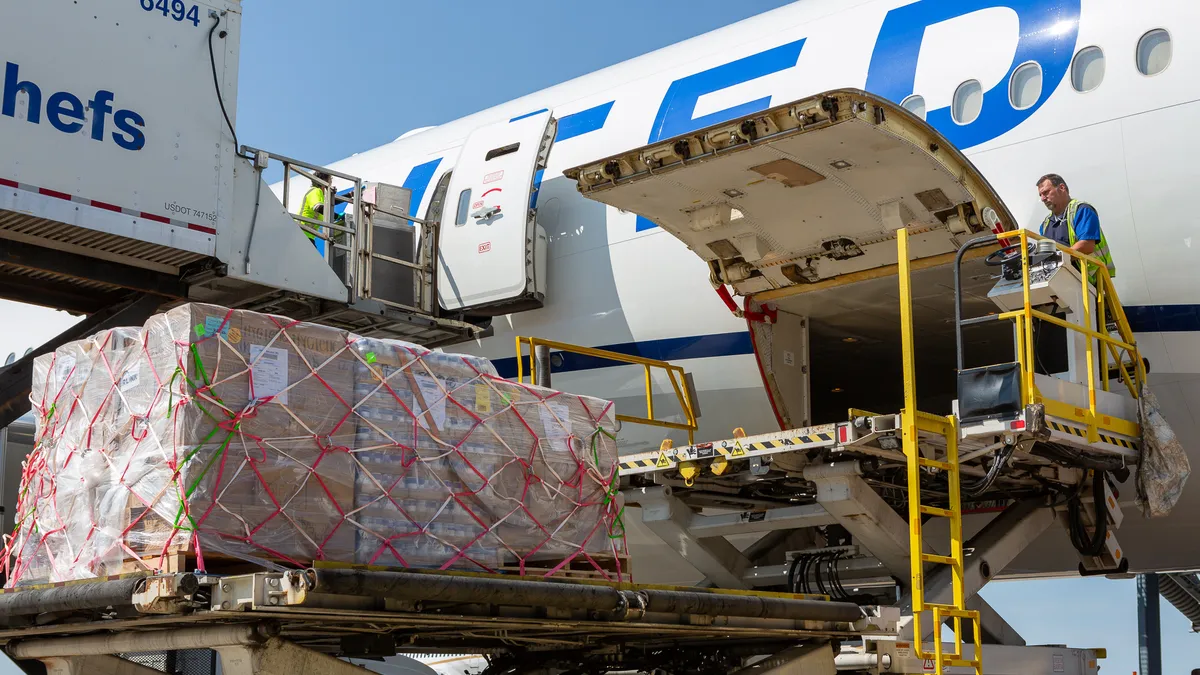Dive Brief:
- Fifty-one percent of employees at companies that directly manage warehouses, distribution centers or fulfillment centers say the coronavirus pandemic has made their company more willing to invest in automation, according to a survey from Honeywell and KRC Research conducted between April 21 and May 7.
- The ability for companies to increase social-distancing measures within their facilities has been the biggest benefit of automation during the pandemic, according to respondents who said automation had either been a significant or moderate help during the pandemic (46% of those surveyed).
- More than any other industry, respondents that worked in e-commerce suggest their companies are more willing to invest in automation as a result of the pandemic (66%) and it was the industry most likely to report automation as having been helpful during the pandemic thus far (54%).

Dive Insight:
A company's interest in robotics during the coronavirus pandemic will partially depend on how it has been impacted financially, as the world continues to wade through the economic shock, according to Herman Herman, the director of the National Robotics Engineering Center at Carnegie Mellon University, who works with public and private sector clients on robotic solutions.
"Many companies [are] now in difficult financial stress. So, some companies pull back on [research and development] investment," Herman said in an interview with Supply Chain Dive. "That's to be expected."
But other companies see automation and robotics as a way to make their operations more robust, safer and generally keep them up and running during the pandemic, he said.
"Certainly robotics can help," he said. "Especially as a way to reduce the density" of employees as companies put social-distancing measures in place.
Gap is one of the companies that has changed its robotics strategy as a result of the pandemic. Last month, Kindred AI announced the retailer had purchased 73 of its SORT robots to install in its U.S. distribution centers, which would bring its total fleet to 106. Gap plans to complete the installation this month, according to Reuters.
"We’re pleased that our partnership with Kindred has grown from a test pilot to a full deployment of their SORT robots across our U.S. network — especially at a time when we’re trying to keep our employees safe," Kevin Kuntz, SVP of global logistics fulfillment at Gap, said in a statement.

Stay-at-home orders and quarantine measures around the world meant that Gap's physical stores were shuttered. But the brand saw a 40% increase in customers migrating from retail only to multi-channel in the first quarter of 2020 compared to the same time last year, according to the company's earnings. The SORT systems already in place have helped to sort more than 13 million units of merchandise between Jan. 1 and April 30, Kindred said in a release.
Gap and Kindred were working together before the pandemic disrupted their operation — the pandemic just created more of an immediate need for the technology, which has been the case for many companies, Herman said.
"In some sense, this is just accelerating the trend that's already there," he said.
Matt Wicks, the chief robotics solution architect at Honeywell Intelligrated, said people are interested in robotics now for the same reason they were interested in robotics before: Accessing labor is difficult. Prior to the pandemic, access to labor was made difficult due to low unemployment, but now it's driven by company facility size and social-distancing requirements.
During the pandemic, customers have shown increased interest in Honeywell's automated truck unloading robot, which the company announced last year.
"A lot of our customers will put multiple people into these trucks to help unload," Wicks told Supply Chain Dive in an interview. "And so now, with social distancing, there's a reduction in the number of people and therefore a reduction in the throughput."
The Honeywell robot is able to operate at a faster pace than a single person, and the company is seeing "significant interest," he said.
The increased interest and reported helpfulness of robotics in the e-commerce sector shown in the survey likely stem from the industry's prior investment in the technology. The e-commerce fulfillment process includes numerous manual processes, and the access to labor has "historically been a pain point for e-commerce companies," Wicks said.
"It's kind of like putting a different spin on the same problems that they've been experiencing," he said.

In a recent safety white paper, XPO Logistics said automation is part of its "risk mitigation process" during the pandemic.
"We didn’t foresee a global pandemic, but we saw a need for companies to have deep visibility into their supply chains with the ability to optimize results in real time," XPO CIO Mario Harik said in a statement emailed to Supply Chain Dive."Our tech has helped our customers navigate the crisis, and we'll continue to invest in proprietary capabilities going forward."
More transformative robotics applications, where the company has not yet invested in infrastructure, will take a longer time to implement. Herman used the example of a restaurant that might turn to telepresence robots to limit their employees' interaction with customers.
Deployment like that requires quite a lot of planning, he said, adding that this is why many of us still don't see robotics on our trips to the grocery or retail store.
Companies looking to aggressively move up their timeline for robotics installation might run into roadblocks depending on the company they're working with and whether their manufacturing operation was shut down as a result of the pandemic. Overall, though, "that industry is still chugging along," Herman said.
"I think automation and robotics could be really, really critical in keeping a healthy robust supply chain,"Herman said, adding that it is not the end-all-be-all solution for companies.
This story was first published in our weekly newsletter, Supply Chain Dive: Operations. Sign up here.













